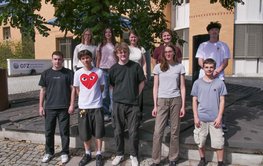
We welcome our trainees, FJN participants, and dual students to GFZ. The new training year begins on September 1.
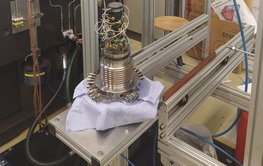
This dynamic is significant for the occurrence of material failure, for example in landslides or earthquakes.
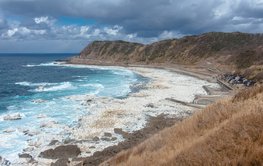
Scientists from GFZ and colleagues observe and model a rare geological process called "same-dip double subduction".
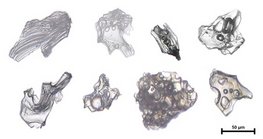
Tiny volcanic glass particles are important time markers for reconstructing climate dynamics in Northern Europe. Their discovery significantly improves sediment age models.
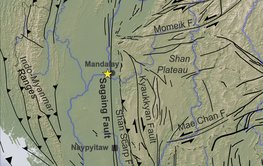
Analysis confirms that Myanmar experienced a “supershear” event with the highest rupture velocity measured since 2002.
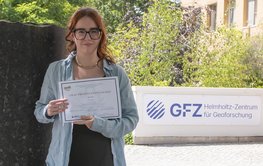
The German Mineralogical Society (DMG) honours Candice Filoche with the ‘Best Talk Award’ at the Section Meeting for Geochemistry and Petrology/Petrophysics for young scientists.
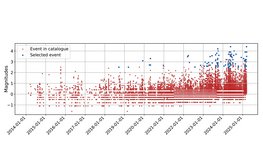
Analysis of the increasing seismic activity in recent years has revealed, among others, fluid-filled, crack-like structures. This offers new approaches to risk assessment.
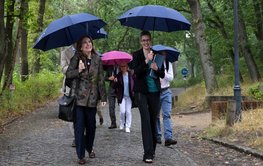
The exchange strengthened joint research initiatives on energy, climate protection, and geoscientific innovation.
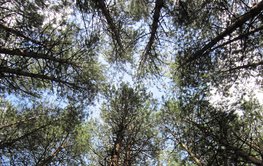
The EU's forests are becoming less and less able to absorb CO₂. Researchers reveal causes and recommend countermeasures.
![[Translate to English:] Map](/fileadmin/_processed_/4/6/csm_Map_ELISE_3958864db8.png)
Looking deep underneath the Vogtland region: 300 temporary seismic stations to find out more about frequent earthquake swarms
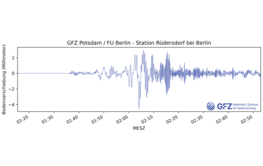
The quakeoff the east coast of the Russian peninsula at 1:24 a.m. CEST is the strongest worldwide since 2011. A tsunami warning had been issued for the Pacific.
![[Translate to English:] Portraitfoto](/fileadmin/_processed_/3/d/csm_20250715-kachel_Paola-Vannucchi_-c-Jason-Morgan_75f2778037.jpeg)
During her research stay, Paola Vannucchi will focus specifically on the interactions between climate, sedimentation, and tectonics in subduction zones.
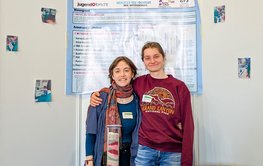
Sophie Fallis and Anna Nerlich showed how environmental conditions have shaped bacteria in the 'Heiliger See' lake over centuries.
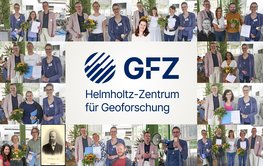
15 outstanding researchers and employees from science management, technology and administration were honoured.

The mini-satellite mission led by the GFZ provided unique data on the Earth's gravity field, magnetic field and atmosphere for over 10 years.

The appointment was awarded for the field of Biogeochemistry, in which Kallmeyer has been researching for over two decades.

Heidi Kreibich presented recent advances in this area while focusing on Regional Flood Models (RFM), 2D flood simulations (RIM2D) and paired event analysis.

Launch of the EU project ‘EQUIP-G’: Unique insights into the inner structure of the Earth through high-precision terrestrial gravity measurements.

More than twice as many data points as 2016: new edition of “World Stress Map” important basis for earthquake research and use of geological subsurface

Regenspurg has been awarded the title of adjunct professor for “Geothermal Fluids” at the Institute of Geological Sciences.

Together with Andrea Lübcke, her designated successor as Member of Parliament, she visited the Satellite Laser Ranging Station and Helmert Tower

Study in Nature Cities based on citizen science with Nightlight-App shows: Not only streetlights contribute, but also advertising, decorative lighting and private windows.
![[Translate to English:] Mine and water](/fileadmin/_processed_/7/f/csm_Figure_PHS_greece_f34476c373.png)
Using novel reaction path modeling, it has been clarified whether the operation of pumped storage power plants affects water quality.

The junior group leader in Section 4.5 Subsurface Process Modelling has been appointed Professor of Geosystem Modelling.

5-kilometre fun run, team spirit and great performances. The colleagues put their sporting skills to the test.

On board the floating science centre: interactive exhibits on future energy, also from the GFZ. Join ‘Dialogue on Deck’ on 20.5. in Potsdam.

The GFZ stands on water and emissions attracted numerous visitors - a total of more than 8,000 came to the Science Park Golm.

How pieces of continental crust collide, merge, and shape ocean-continent back-arcs: Study offers a new model which may resolve a long-standing debate

These days, over 180 GFZ researchers are travelling to Europe's largest geoscience conference, with 19,000 participants from all over the world.

The quakes, measured by the GFZ's GEOFON programme, occurred ~60 km southwest and directly south of Istanbul at a depth of ~10 km under the Sea of Marmara.

Prof. Yuri Shprits argues in “Nature Physics” for a stronger coordination within the research field of physics of our solar system.

Satellite-based research at the GFZ began on 19 April 1995 with the launch of the football-sized mini-satellite GFZ-1 from the MIR space station.

At the world's leading industrial trade fair, the GFZ presented innovations in areas such as deep geothermal energy and geological hydrogen storage – visited by Brandenburg's Economy Minister.

For one day, young people from 7th to 9th grade were able to slip into a profession of their choice. 112 pupils were given an insight into everyday working life at the GFZ on this year's Future Day.

Georesearch is a public service, securing livelihood, as most resource issues as well as many natural hazards are geo-related.
![[Translate to English:] Map Myanmar](/fileadmin/_processed_/b/4/csm_20250328-1300-Slider-01_EarthquakeExplorer-GFZ_84e0c0a796.jpeg)
The quake occurred near the city of Mandalay, which has a population of 1.5 million. The epicentre was located on the Sagaing fault, where the Indian and Eurasian tectonic plates collide.

The head of GFZ section ‘Dynamics of the Lithosphere’ has been appointed as adjunct professor at the Johannes Gutenberg University in Mainz. He is already professor at Università Roma TRE.

The head of a working group in GFZ section 4.2 ‘Geomechanics and Scientific Drilling’ will represent the field of ‘Applied Seismology’ at RWTH Aachen University and continue her research at GFZ.
![[Translate to English:] A painted, open book from which various contents fly up, with the words “Open Science Day 2025” above it](/fileadmin/_processed_/e/e/csm_20250325_Open-Science-Say-2025_-c-pengzphoto-adobe_6977d5aaed.jpeg)
At the first GFZ Open Science Day, theory and practice of open science at the GFZ and in the geosciences were reported on and discussed. The event was hosted by the GFZ Department of Geoinformation.

The Director of Department 5 Geoinformation will represent “Geodata Science” at the LMU Faculty of Mathematics, Computer Science and Statistics in addition to his work at the GFZ.

The island of Anydros is located directly above the active zone near Santorini. Using an array of seismometers, small earthquakes and other movements will be detected.

The science journalist and photographer Tim Kalvelage is a guest in the section of Liane G. Benning.

The analysis of 31 earthquakes in the Marmara-Istanbul region shows preferred rupture directions associated with increased energy transport towards the megacity. This is important for hazard maps.

Kick-off for the developing the Helmholtz research infrastructure SAFAtor: Unique real-time data from the bottom of the deep sea for climate and geo-hazard analysis.
![[Translate to English:] Portrait von Philipp Weis](/fileadmin/_processed_/9/8/csm_Weis-Phillip_-c-Michael-Bahlo_ff1aebae5c.jpeg)
The geologist and expert in mineral deposits from section "Inorganic and Isotope Geochemistry" has been teaching as a private lecturer since 2016 and has now been appointed adjunct professor.

DLR researchers, with the participation of GFZ, rule this out in a Nature study, based on calculating the planet’s deformation under the ice cap using gravimetry, radar and seismic data.

GFZ researchers identify where to expect natural and exploitable hydrogen resources using state-of-the-art simulations of plate tectonic processes

More than 60 participants honoured the recipients of the 2023/24 transfer prizes and took the opportunity to exchange information and ideas on transfer strategies and opportunities at GFZ.

Around the Greek volcanic island of Santorini, there has been an accumulation of weak to moderate earthquakes since 24 January 2025. Experts from GEOMAR and GFZ classify the events.
![[Translate to English:] Portrait Prof. Warner Marzocchi](/fileadmin/_processed_/f/4/csm_Warner_Marzocchi_423ac69ef1.jpeg)
Prof. Warner Marzocchi was appointed as a new member of the Scientific Advisory Board of the GFZ Helmholtz Centre for Geosciences at the 64th meeting of the Board of Trustees on 13 November 2024.
![[Translate to English:] [Translate to English:] Portrait Johann Komusiewicz](/fileadmin/_processed_/0/4/csm_Johann_Komusiewicz_schwarzer_Rahmen_f85d9a28a3.png)
The GFZ mourns the loss of Dr. Johann Komusiewicz, who was deputy chair of our Board of Trustees from May 2006 to February 2010.

The head of the ‘Geochemistry of nuclear waste disposal’ working group presented her research about Neptunium migration in Opalinus Clay, with impact for radioactive waste confinement.

„The destruction caused by the fires is unbelievable. Our thoughts are with the people on the ground and we feel and fear with them,“ says Susanne Buiter, Scientific Director of the GFZ.
![[Translate to English:] Fire in a forest, smoke rising, aerial view from above](/fileadmin/_processed_/8/3/csm_2025_01_06_AdobeStock_415831729_ae7c6bbfc1.jpeg)
The example of North America shows: For up to five decades, the changed height and tree canopy structure influences the heat exchange between forests and the atmosphere.

As of 1 January 2025, the former “Helmholtz Centre Potsdam – GFZ German Research Centre for Geosciences” is known as “GFZ Helmholtz Centre for Geosciences”.

Thanks to the GITEWS (now InaTEWS) early warning system developed under the lead of the GFZ from 2005 to 2008, it is not only the Indian Ocean that is better prepared for such natural hazards today.
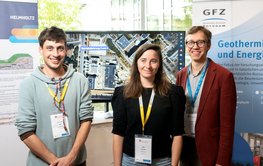
The GFZ was the main scientific partner. GFZ researchers Lioba Virchow and Mikhail Tsypin won the poster competition for young scientists, Johannes Hart reached the final.

35 of 197 coastal structures examined on the barrier islands off Miami sank by up to eight centimetres in 2016-2023 – presumably due to the compaction of sand layers in the underground.

The Nepalese Foreign Minister Dr Arzu Rana Deuba visited the GFZ. In focus: cooperation on an innovative early warning system for natural disasters such as glacier and landslides.

It provides important information for the construction of Berlin's largest heat storage facility in Adlershof. The aim is to store heat from renewable sources underground in summer for use in winter.

The GFZ mourns the loss of Achim Ohlert (née Morschhauser). The colleague from Section 2.3 ‘Geomagnetism’ died on 9 November 2024 at the age of 41 after a long illness.

The aim of her ERC Consolidator Grant project EXCURSION: The first data-based model of the Earth's magnetic field over the last 780,000 years, focussing on periods of magnetic weakness.

The former post-doc from the ‘Earthquake Hazards and Dynamic Risks’ section will investigate the complex dynamics of the growing risk of landslides, particularly for tropical cities.
![[Translate to English:] [Translate to English:] Abror Gafurov von dem Schriftzug "Welcome to Azerbaijan" und den UN und COP Logos](/fileadmin/_processed_/2/5/csm_2024_11_Baku_COP29_Abror_Gafurov_512f85b5e2.jpeg)
The long-term goal is an early warning system for all natural hazards and all the people on earth. Interview with Abror Gafurov on the occasion of the COP29 in Baku.

She was awarded the International Hydrology Prize by the IAHS, UNESCO and WMO for her work on analysing and managing flood risks at a conference in Brazil.

The IHK Potsdam honoured the most successful trainees of the year. Noah Schmidt completed his apprenticeship as an electronics technician at GFZ with an outstanding exam. Congratulations & interview
![[Translate to English:] Martin Herold standing in front of the library on the Telegrafenberg](/fileadmin/_processed_/c/d/csm_Martin_Herold_1cfbe99391.jpeg)
‘We need to focus more on land use change,’ says Prof Martin Herold in an interview on the occasion of the 29th Conference of the Parties to the UN Framework Convention on Climate Change COP29 in Baku
![[Translate to English:] Many people are listening to a presentation in the GFZ lecture hall.](/fileadmin/_processed_/c/a/csm_1_Bild1_hell_6be603fa54.jpeg)
At the 22nd Autumn School of the GFZ School Lab, scientists from various research institutions offered training to around 100 teachers on the topic of ‘Urban spaces: hotspots in the Earth system’.

The committee advises the National Research Data Infrastructure NFDI. It aims to optimise the indexing, storage and access to the increasing amount of research data.

New genetic methods can differentiate between the DNA of living and dead microorganisms. This enables deciphering the diversity of life and its processes under extreme conditions.

In the EU project GERACLE, an international team coordinated by the GFZ will investigate consequences of polarity reversals in the Earth's magnetic field. 3.3 of 10 mio euros will go to the GFZ.

In October 1994, the drilling for the deepest hole in Germany reached its final depth of more than 9 kilometres. A ceremony with an open day was held on site in Windischeschenbach (Bavaria).

Twitch streamer Sofia Kats & Felix Pohl from the UFZ reported live in a new format of science communication - about drones & satellites, mountain formation & earthquakes. Watch the video here.

A review in questions and answers by experts from the Helmholtz Research Field “Earth and Environment”: GFZ, Helmholtz Centre for Environmental Research UFZ and Karlsruhe Institute of Technology KIT
![[Translate to English:] Both scientists sitting on stools in front of a wall of books in the Telegrafenberg library](/fileadmin/_processed_/6/6/csm_Buiter_Castell_DORA_4_38f987ebba.jpeg)
In an interview, GFZ Scientific Director Susanne Buiter and Wolfgang zu Castell, Department Director Geoinformation, explain the background to the ‘Declaration on Research Assessment’ (DORA).

The birthday of the Central Asian Institute for Applied Geosciences – a joint foundation of the GFZ and the government of Kyrgyzstan – was celebrated with a congress in Bishkek.

Prof Dr Magdalena Scheck-Wenderoth, Director of Department 4 ‘Geosystems’, takes over the Chair of ‘Sedimentary Basins and Georesources’ in a joint appointment with the GFZ.

The German Quaternary Association honoured the former head of the GFZ section ‘Climate Dynamics and Landscape Development’ for his outstanding scientific achievements in Quaternary research.

Sustainable procurement for the RIM2D flood forecasting model wins an award: Computing power can either be driven for economy or speed

In his 6 months’ stay in section 4.7 Earth Surface Process Modelling with Prof Jean Braun, the Earth Scientist from Colorado State University will address how climate affects landscape evolution.

The head of GFZ’s “Projects & International Affairs” has been elected on the 37th World Congress of the “International Union of Geological Sciences” (IUGS) in South Korea by the General Assembly.

On the day of bulding culture, join our guided tours at GeoBioLab: How to investigate microbial processes underground? How can computer power heat laboratories? How does sustainable building work?

The GFZ Friends Award honours Smirnov's dissertation on the dynamics of near-Earth space, completed in GFZ section ‘Space Physics and Space Weather’, as the best doctoral thesis of 2023.
![[Translate to English:] Ice landscape with five red tents](/fileadmin/_processed_/8/9/csm_Zeltlager_auf_dem_Eis_Urheberin_Jenine_McCutcheon_ebb7cd0301.jpeg)
Saturday, 9/14 | 17:30 | Public lecture by GFZ researcher Liane G. Benning at GDNÄ meeting: What algae have to do with the ice melt on Greenland

With the prestigious EU funding of 1.5 million euros, he will conduct research into past ecosystems and the development of the carbon cycle and complex life in the GFZ section “Organic Geochemistry”.

On 2 September, eleven trainees in scientific/technical and commercial fields and two volunteers started their training with an induction day. A warm welcome!

The Head of the Inorganic and Isotope Geochemistry Section has been awarded by the European Association of Geochemistry and will give lectures in Eastern Europe on Cu and Zn deposit formation.

Kanat Bozumbayev and his delegation met with the Scientific Director and other experts at the GFZ to discuss natural hazards and options for protecting the population.

Data assimilation, a principle known from weather forecasting, can – based on satellite data – significantly improve the prediction of particle dynamics in the electron ring current around the Earth

Borehole-based station at the Sea of Marmara will record an entire range of deformation processes, from slow aseismic creep to classic earthquakes as well as pore fluid pressure data.

As part of an ideas competition, five technology transfer projects and three knowledge transfer projects have been selected for funding.

Why are the tectonically stable core areas of the continents gradually rising? How do some of the most distinctive landforms on our planet form?

The Minister presented the two GFZ board members with a plaque bearing the silver certificate for sustainable building. The GeoBioLab was honoured for its innovative energy concept.

From 22 to 24 October, the industry's largest event will take place in Potsdam for the first time. The GFZ will be the scientific partner of the organising Bundesverband Geothermie e.V.

The Head of ‘Operational Management’ at the GFZ is a member of the newly founded Brandenburg Scientific Climate Council, which advises the state on how to achieve its climate targets.

Using simulation and AI, it was possible for the first time to break down the mass change responsible for polar movement into individual components – including the melting of large ice masses.

On July 15, 2024, the Kyrgyz Ambassador Omurbek Tekebaev visited the GFZ. Further possible fields of cooperation in research, education and training were discussed.
The new TrueTriax high-pressure testing system can simulate a wide range of processes on rock samples down to 10 km depth. This provides important data for geoenergy research & applications.

Sediment cores off the Nile mouth reveal insights into effects and causes of heavy rainfall episodes about 9,000 years ago. That will help to prepare for weather extremes in a changing climate.

The PhD student in the ‘Geoenergy’ section is being honoured by the umbrella organisation for geosciences. In addition to her hydrogeological research, she is also involved in the ‘Young FH-DGGV’.

This year's Doctoral Student Days took place on 17 and 18 June under the motto "Harvesting Knowledge, Thriving together!"
![[Translate to English:] Heidi Kreibich, woman with short brown hair and blue eyes. She is wearing a grey cardigan and a red polo shirt](/fileadmin/_processed_/6/6/csm_kreibich-Heidi_1_Querformat_he-2021_7269b57315.jpeg)
Heidi Kreibich wird für ihre herausragenden Beiträge zu Hochwasserrisiken im November mit der Volker Medaille des Internationalen Hydrologiepreises der IAHS ausgezeichnet.

President Ram Chandra Paudel and his delegation informed themselves about current and possible future cooperations between Nepal and the GFZ against the background of increasing climate change.

German-American space dialogue underlines the importance of the “spirit level in space”. The third generation of the satellite duo is currently being planned.

Anthony Eliot Striker and Tina Thao-Nhi Schatz impressed the jury in the ‘Biology’ category with their project on a microbial fuel cell, carried out in Jens Kallmeyer's working group.

The head of the space weather activities of the Geomagnetism Section has taken over the office for the Solar-Terrestrial Sciences Division of the European Geosciences Union (EGU).
![[Translate to English:] [Translate to English:] Totes Meer gesehen von einem Hügel am Ufer](/fileadmin/_processed_/0/f/csm_20240612-web_AdobeStock_151245578_52f45a0801.jpeg)
The first discovery of CI Tephra in the Dead Sea provides insights into the timing of the climate shift across the Mediterranean ~40,000 years ago

Land uplifts at subduction zones are the result of thousands of small quakes. This makes it possible to estimate the size of locked plate areas and the location and strength of future large quakes.

Rising sea levels increase the pressure on tectonic faults and lead to changes in their seismic cycles – leading to an increasing number of earthquakes particularly in the world's coastal regions.
![[Translate to English:] Gruppenfoto im Hörsaal](/fileadmin/_processed_/8/a/csm_240528-GfZ-ERC-Grantees-Gruppe_afb35f975c.jpeg)
State Secretary Dünow from the MWFK congratulates: “The GFZ provides forward-looking impetus for international geological, environmental and climate research”
![[Translate to English:] Susanne Buiter in front of a blue wall with GFZ logo](/fileadmin/_processed_/d/7/csm_20220721-GFZ-Portrait-Buiter-1-he-web_-c-Reinhardt_Sommer_f485bb3dfa.jpeg)
The objective of Academia Europaea is to encourage the advancement of excellent scientific achievements.
![[Translate to English:] [Translate to English:] Drohne](/fileadmin/_processed_/b/a/csm_20240515_155801_3e8edff298.jpeg)
Whether as copters or gliders, with laser, radar or hyperspectral sensors - drones provide important services for monitoring forests or peatlands, analyzing volcanoes, minerals & more.

On the occasion of the German Embassy's festival, Executive Director Susanne Buiter and Ludwig Stroink, Head of Projects & International Affairs, established further valuable contacts in Estonia.

Combining various forecasting models enables more precise forecasting of flood impacts – with water levels and dynamic, high-resolution flood maps.

On 4 May, the event took place for the first time on the Telegrafenberg. The varied programme invited visitors to engage in lively discussions about current research and to experiment for themselves.
![[Translate to English:] Lecture room at GFZ with participants](/fileadmin/_processed_/a/9/csm_P1140796__002__4817e9befb.jpeg)
Achim Brauer, the former head of the GFZ section Climate Dynamics and Landscape Development, was given a retirement farewell at a colloquium of the European research network INTIMATE.
![[Translate to English:] PTDW](/fileadmin/_processed_/a/0/csm_PTDW2024-2-1_fcadce612f.png)
On Saturday, May 4, you will find a great science program and many stands on the unique Telegrafenberg. Come and have a look from 1pm to 7pm! Free admission!

Organised by the GFZ's School Lab, 50 young pupils got to know the wide variety of job opportunities at the GFZ – in science and laboratories, as technicians or administrative staff.

Charlotte Krawczyk has been Director of Department 2 “Geophysics” again since 1 April. Michael Kühn took over as Head of Department 3 “Geochemistry” on 1 March.

The delegation from the African country met with GFZ representatives to discuss possible cooperation, e.g. in geothermal energy and raw materials, climate change and the risk of natural hazards.

Thanks to novel molecular DNA analysis, viable microbes have been detected down to depths of 4.2 metres – with implications also for the search for extraterrestrial life.

The Helmholtz Association is investing 23 mio euros in four pilot projects and the infrastructure to research a new generation of basic AI models. GFZ participates in project on carbon budget.

In these Italian mountains, CO2 emissions from deep rock are more important than the CO2 balance of weathering on the surface – at least where Earth's crust is thin and the heat flow is high

A recently installed monitoring network of seismic sensors in boreholes recorded thousands of earthquake signals – a unique data set for researching the cause of swarm earthquakes.
![[Translate to English:] René Steinmann and Jana Täumer](/fileadmin/_processed_/d/e/csm_20240415_Discovery-Fellows_8fd64d85c9.jpeg)
Two new GFZ Discovery Fellowships awarded: René Steinmann is researching ground vibrations in connection with animal movements and Jana Täumer is researching methane sinks in Germany.

Experiments at a wind farm in Nauen near Berlin show that man-made buildings have a similar effect to a metamaterial and modify seismic waves.

The region around the city of Hualien on the east coast of Taiwan has been shaken by an earthquake with a magnitude of 7.4. The media report 9 dead and hundreds injured.

Mrityunjay Singh and Ingo Sass were honored for their outstanding publication on the optimal planning of geothermal systems.

Jürgen Matzka, working group leader in the Geomagnetism Section, is new Chair of the Operations Committee and member of the Executive Council of the global network of geomagnetic field observatories.

Hypothetical but not improbable flood scenarios are intended to motivate people and decision-makers in at-risk regions to better prepare for potential extreme events.

On 25 March, a shallow earthquake with a magnitude of 3.5 shook the district of Diepholz in Lower Saxony. The possible cause is natural gas extraction in the region.

The GFZ welcomes Dr. Sarwar Nizam, who is working as a fellow of the Alexander von Humboldt Foundation at GFZ since March.

GRACE-FO data show: Slight recovery compared to drought years, but billions of tonnes of water still missing. New GFZ info portal for background, news & data of the GRACE-FO satellite mission.

The third-generation of the successful satellite duo will continue to measure the Earth's gravitational field and thus provide unique insights into the global water cycle.
![[Translate to English:] [Translate to English:] Insel-Vulkan mit Aschewolke, im Vordergrund ist ein ruhiges Meer zu sehen](/fileadmin/_processed_/2/7/csm_20240311_Anak-Krakatau_AdobeStock_69905047_d86578885b.jpeg)
Flank collapses on coastal areas and volcanoes can trigger so-called atypical tsunamis. Thanks to the "Tsunami_Risk" project, such hazards are taken into account in the Indonesian early warning system

A study in Science on the erosion dependence of the CO₂ balance during weathering showed that there is an erosion rate at which CO₂ storage through weathering is maximised.

She learned about topics such as geothermal energy, the geological storage of hydrogen, the GFZ satellite missions, earthquake risk, the use of data cables for seismics and the GFZ spin-off DiGOS.

This is shown by studies on fossil pollen, spores and geochemical data from fossilised soils. They also provide insights into future developments under extreme climatic conditions.

A scientific colloquium provided an opportunity to look back on a successful career and the development of geodesy - from the past to the future.
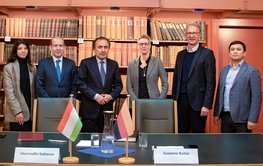
Ambassador Dr Imomudin Sattorov and his delegation learned about German-Tajik research projects and the GFZ's commitment in Central Asia and discussed the expansion of cooperation.

The ERC Consolidator Grant project “WIRE” will investigate the interaction of ultrafast electrons and plasma waves in the radiation belts around the Earth – also to protect satellites.

Study shows that the continuous discharge of industrial wastewater can trigger earthquakes in fault zones even after 10 years

With satellite data and machine learning methods, it is possible to identify and locate 15 forms of land use – from the cultivation of various crops to pastureland and mining.

Under the motto “Broadening Horizons”, the international scientists will spend three months at the GFZ – funded by the Helmholtz Information and Data Science Acade-my (HIDA).

Organised by the GFZ Section 4.4 “Hydrology”, the community met to discuss the quality and potential fields of application of the new type of device, which can now also be used outdoors.

A year ago, the Earth shook in the Turkish-Syrian border region. The high number of victims was not expected. Q&A and relevant studies.
![[Translate to English:] Portrait photos of four men](/fileadmin/_processed_/9/0/csm_20240129_quattuorychon_2bc215bec5.jpeg)
Harald Schuh retired. Maik Thomas succeeds him as Director of Department 1, Jens Wickert as Head (interim) of Section 1.1. Henryk Dobslaw becomes Topic 2 Director of the GFZ-Research Programme.

Liane G. Benning, Head of GFZ Section Interface Geochemistry, will be a member of the Federal Government's highest advisory body on overarching scientific issues for three years from 1 February.

GFZ scientists presented their work on remote sensing technologies for digitalisation in crop production.

The analyses of the 2021 Iceland eruption shows: Machine learning and musicological methods can help to recognise precursors and phases of volcanic eruptions in seismic signals at an early stage
![[Translate to English:] Kollage mit Firmenlogos oben und dazu passenden Fotos unten. Die Fotos zeigen: Links – Ein Mann steht in Warnweste an einer menschenhohen Messstation neben einer Autobahn. Mitte – Gruppenbild mit 5 Menschen. Rechts – Ein Mann hockt in gelber Warnweste mit Firmenlogo auf einer Wiese und hat ein Messgerät in der Hand.](/fileadmin/_processed_/9/2/csm_20240119-Kachel_SpinOffs-2023_2f10b8fd3e.jpeg)
GreenGate Genomics offers bioinformatic solutions for complex microbiomes, fluxtec provieds high-resolution gas emission mapping and FOMON’s expertise is in structural monitoring with fibre optics.

The Supervisory Board of the Karlsruhe Institute of Technology (KIT) elected Jan S. Hesthaven as President and Stefan Schwartze as Vice President of KIT. Next step is confirmation by the KIT Senate.

Fault roughness and stress heterogeneity control induced seismicity. This is important for hydraulic stimulation in reservoirs.

The GFZ mourns the loss of its former Administrative Executive Director, Dr Bernhard Raiser, who passed away on 28 December 2023 at the age of 77.

Susanne Buiter is Vice President of the Helmholtz Association for the research field "Earth and Environment" for the next two years

GFZ hydrologists Bruno Merz and Sergiy Vorogushyn provide information on the causes and challenges of flood protection and risk management.

The European Geoscience Union honours Claudio Faccenna, Anne Glerum and Sarah Incel for their GFZ projects and their achievements in the geosciences.

On the basis of a superconducting gravimeter, the international research project aims to investigate the Alpine water balance with the Zugspitze as an example.

The head of Section 3.5 Interface Geochemistry was re-elected to the Review Board for Mineralogy, Petrology and Geochemistry. She is the only representative of the GFZ in these DFG boards.

PD Dr. Wolfgang zu Castell was elected to the Administrative Committee of the German National Research and Education Network (DFN).
![[Translate to English:] Torsten Sachs in front of a climate station on a field](/fileadmin/_processed_/3/9/csm__TorstenSachs_bearbeitet_GS_90f1c30829.jpeg)
Torsten Sachs, working group leader in GFZ Section 1.4 Remote Sensing and Geoinformatics, is appointed professor at TU Braunschweig.

The report "State of Global Water Resources 2022" by the World Meteorological Organization WMO has recently been published. It contains important contributions from the GFZ.
![[Translate to English:] left image flood at the Ahrtal: image from above, several houses are flooded; left image:: Heidi Kreibich;](/fileadmin/_processed_/4/4/csm_Bild2_1bdb9157ba.png)
The scientist form the section 4.4 hydrology at the German Research Centre for Geosciences was re-elected as President of the EGU Division on Natural Hazards for the coming 2025-2027 term of office.

42 kilometres: This is the average thickness of the Earth's continental crust, but why is that so? What does this mean for plate tectonics?

The guest researcher from Section 2.6 received the 20,000 euro award for his Nature publication on the risks of landslides due to climate change and urban sprawl. Call for 2024 started.

Leandra Weydt (r.) and Lena Muhl (l.), who are both conducting research as part of GFZ projects, were honoured at the German Geothermal Congress.
![[Translate to English:] Start der Vega Rakete](/fileadmin/_processed_/6/4/csm_20231201-kachel_Vega-VV23-launch_ESA-CNES-Arianespace_8f6efa4f64.jpeg)
The demonstration mission is intended to show what this type of small satellite can do. GNSS reflectometry measurements can very accurately display sea, glacier ice and wave heights.

Olaf Scholz, as a member of the Bundestag, and Brandenburg's Science Minister Manja Schüle visited the GFZ, PIK and DiGOS to discuss geothermal energy, hydrogen storage and the energy transition.

Christopher Kyba's publication on light pollution is voted first place in the "Wissen der Vielen – Forschungspreis für Citizen Science" and receives prize money

Sascha Brune, Head of Section 2.5 Geodynamic Modelling, is appointed Professor of Tectonophysics at the University of Potsdam with effect from 01.12.2023.

Latest analyses of data from the region since 2014 show signs of precursor phenomena in the form of spatially and temporally clustered quake sequences in the 8 months before the quake
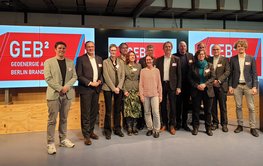
Eight partner institutions, including the GFZ German Research Centre for Geosciences and the Fraunhofer IEG, conclude a cooperation agreement to promote a low-CO2 and import-independent energy supply.

Special fine structures were identified in thousands of tiny zircon crystals using transmission electron microscopy – as evidence in favour of the impact theory.

The ERC Consolidator Grant project “Glass2Melt” will investigate glasses and melts under high pressures and temperatures to create a model of Earth’s ancient magma ocean.

The satellite trio still provides high-quality data of the Earth's magnetic field – processed by the GFZ, among others, also for the prediction of space weather and auroras.

Sanja Panovska won the 1.500 euros EGU Outreach Prize 2023 to realize a booklet for kids with games and puzzles about different geoscience fields. In an interview she gives insights into the project.
![[Translate to English:] Poster exhibition at the Brandenburg Hydrogen Day at the GFZ, some participants in the foreground](/fileadmin/_processed_/6/5/csm_Erster_Brandenburgischer_Wasserstofftag_GFZ_c3a49ac373.jpeg)
The German Research Centre for Geosciences and the Brandenburg Ministry of Economic Affairs and Energy are organising the Brandenburg Hydrogen Day for the first time today.
![[Translate to English:] Group picture of the participants](/fileadmin/_processed_/9/4/csm_20231108_CAWa-Workshop-Tashkent_Gruppenbild_417b600f01.jpeg)
As part of the CAWa-Green project, the 6th edition of the “Tashkent Water Security Lectures” took place in Uzbekistan at the end of October – on the topic of water security in Central Asia
![[Translate to English:] [Translate to English:] Hörsaal](/fileadmin/_processed_/e/6/csm_H%C3%B6rsal_37cf7418a3.jpeg)
The Autumn School will take place for the 21st time on 13 and 14 November - with over 70 participants. The title of this year's teacher training programme: "Africa - A continent in the focus of geosci

The GFZ is setting up a temporary seismic network in Ukraine. For this purpose, three special seismometers that can be used by laypersons have been installed in Ukraine. Twenty more are to follow.

One year of EnMAP @Work: the environmental satellite reliably delivers high-quality data. 430 participants from 20 countries, from research, companies and authorities met for the 1st user workshop.
![[Translate to English:] The Delegations in the Historic Library on the Telegrafenberg. In the back there are from left to right, the Dutch Ambassador for Germany, Ronald van Roeden, the Dutch Minister for Education, Culture and Science, Robbert Dijkgraaf and the scientific director of the GFZ, Susanne Buiter.](/fileadmin/_processed_/d/b/csm_Kachel-2_6708d814bc.jpeg)
The Minister of Research and the Ambassador of the Netherlands, Robbert Dijkgraaf and Ronald van Roeden, visited the GFZ for an exchange on talent development and diversity in science.

The Chilean Ambassador Magdalena Atria visited the GFZ to discuss German-Chilean projects with young scientists and to deepen cooperation.

Susanne Glaser has taken over the W3-Professorship “Space Geodetic Techniques” at the University of Bonn on 1 September 2023 and left the GFZ. She talks about her research in a recent DFG video.

Machine learning helps detect precursor phenomena of earthquakes: A new lab-study provides encouraging results for “time to quake” prediction.
![[Translate to English:] In the background: The drilling tower made of metal struts. Next to it, crane equipment. In the foreground, pipe rods.](/fileadmin/_processed_/5/c/csm_20231102_Pipehandler-2_GFZ_21ff80c7f9.jpeg)
Hydraulic stimulation in hot rock - Unique conditions for real-time monitoring of experiment at a depth of four kilometers

Two of the highest EU research awards for the GFZ: With ERC-Synergy Grants, Thomas Walter (r.) will research internal “rotting” of volcanoes & Jens Kallmeyer (l.) metabolism of primordial microbes.

First analyses of satellite and GEOFON data give insights into the processes around the Herat fault, a region that is considered to be seismically rather inactive.

Prof. Friedhelm von Blanckenburg was given a ceremonial farewell into GFZ retirement with a colloquium. Prof. Dirk Scherler (interim) will take over the leadership of the section 3.3.
![[Translate to English:] Picture of Marie Bonitz in front of a dry forrest.](/fileadmin/_processed_/5/1/csm_20231005_Posterpreis-Geo-Berlin_c7594954de.jpeg)
Marie Bonitz, research associate in section 3.4 Fluid System Modelling, was awarded the poster prize (1st place) at this year's GeoBerlin.
![[Translate to English:] Three people are standing on a staircase in front of a yellow house: on the right, the award winner with a bouquet of flowers in his hand. He is being presented with the certificate.](/fileadmin/_processed_/4/d/csm_20230921-kachel_Helmert-Preis_UD_f53334f45d.jpeg)
Ebuka Canisius Nwosu was awarded the Friedrich Robert Helmert Prize of the GFZ Friends for the best doctoral thesis of the year 2022/23 for his doctorate in Section 3.7 “Geomicrobiology”.

The GFZ mourns the death of Dr. Rudolf Stecher at the age of 86. He was head of the section Geoscientific Equipment Technology until his retirement in 2002.
![[Translate to English:] Cover of the new issue of System Earth; above GFZ logo and title "System Erde" in blue, below "GFZ-Journal" in black; below image of light blue river flowing through a stony landscape, text: "Resource, Regulator, Risk: Water in System Earth".](/fileadmin/_processed_/8/5/csm_System_Erde_Ausgabe_1_2023_4e7120bc44.png)
The new issue of the GFZ journal "System Earth" shows some of the important contributions of the geosciences to the topic of water.
![[Translate to English:] shirt, grey patterned jacket and black glasses in front of grey wall](/fileadmin/_processed_/1/3/csm_Sachse-Dirk_Kachel_17d8728a52.jpeg)
Dirk Sachse, who conducts research at the GFZ in Section 4.6 Geomorphology, has been appointed Professor of Organic Geochemistry of the Earth Surface System at the HU Berlin.

We welcomed eleven new faces to the German Research Centre for Geosciences on 1 September. The GFZ wishes all new arrivals a joyful start to this new phase of their lives!
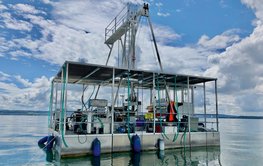
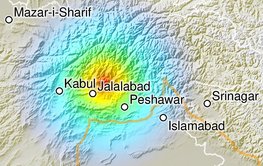
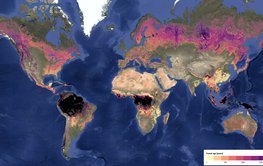
![[Translate to English:] Complex graphic showing the composition and viscosity of the Earth's crust several billion years ago in a semicircular arc.](/fileadmin/_processed_/a/0/csm_active_subduction_27-17_f1f7f7_Schrift_Legende_en_7826ba15da.png)
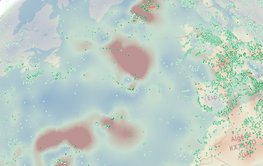
![[Translate to English:] PAGER Products (graphic illustration)](/fileadmin/_processed_/7/1/csm_20250616_Fig3-all_a7cc986a48.jpeg)
![[Translate to English:] Gruppenbild mit 4 Personen](/fileadmin/_processed_/8/d/csm_20241017_GFZ-Emmerman-Medal-005_web_reinhardtundsommer_e6f00dc0df.jpeg)



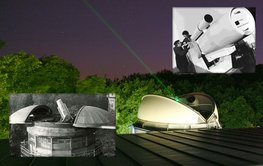
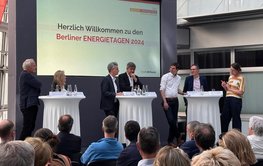
![[Translate to English:] ein riesiges Erdloch in einer kargen Landschaft im Iran mit Bergen im Hintergrund](/fileadmin/_processed_/f/1/csm_DSC_7917_kleiner_754b734646.jpeg)





